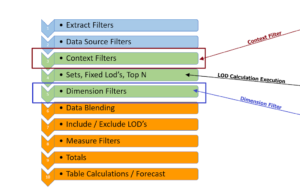Zero to Zen covers the 5 foundational concepts I needed to learn on the journey from spreadsheets to Tableau
Like many, I struggled when first introduced to Tableau 5 years ago. I don't come from a data scientist background. – Actually, I'm an engineer, very analytic and expert level spreadsheet skills but I just didn't get it at first.
Looking back there were 5 concepts that I needed to understand which were not at all like spreadsheets before I was comfortable working in Tableau. Over a 5 week series, I shared those lessons learned – Below are summaries of each and links to the recordings and the workbook used in each session.
Hope you enjoy
Jim
Session 1 – Data Structure and Connections
Three types of connections, Joins, Unions, and Blending, and the limitations of each were covered. Also reviewed were several how to use cases include why it is sometimes necessary to use scaffolding to restructure the data set
Session recording can be found at: Session 1 Recording
The session workbook can be downloaded at: Session 1 Workbook
Session 2 – Order of Operation
Misuse of the Order of Operation is the usual cause when users get unexpected results in their analysis. It is the sequence that Tableau goes through to first create the data table for each worksheet ( That's right – each worksheet has a unique data table that is a subset of the full data set uploaded into Tableau). Once the structure of the data table is established, values are loaded, calculations performed, and the visual presentation created. Frequent areas of error are a misapplication of context filter, trying to filter across blended data sources, and attempting to "fix" table calculations for use on other sheets
Session recording can be found at: Session 2 Recording
The session workbook can be downloaded at: Session 2 Workbook
Session 3 – Simple Calculations and Date Functions
This first session on calculations covers the use of the Calculation Wizard, using aggregations to do simple math calculations, If – Then conditional statement, and date functions. Dates are a special data type in Tableau which self sequence, sort, and allow the use of the 4 types of Date Functions – those which return dates, refer to dates, are used in date math, and the 2 special Today() and Now(). Use case show how dates are treated as discrete or continuous or can still be continuous yet presented as discrete
Session recording can be found at: Session 3 Recording
The session workbook can be downloaded at: Session 3 Workbook
Session 4 – LOD Expressions and Table Calculations
My favorite, LOD expressions provide versatility by allowing the user to create layers in the data set and then use the layer like any other measure in calculations, nested in other LOD's or table calculations. Table calculations are last in the order of operation and are executed on the data table for the specific worksheet making the unique the sheet where they are applied. Use cases reviewed nesting LOD's in table calculations, nesting table calculations, totally Top N and Other and the use of Show Hide filters
Session recording can be found at: Session 4 Recording
The session workbook can be downloaded at: Session 4 Workbook
Session 5 – Filters, Sets, and Parameters
Filters, sets, and parameters are the user interface to the viz, allowing users to probe and drill into the data and gain meaning and understanding. Filters remove data and change the structure of the data table for the worksheet, sets retain all the data in the data table but categorize it into the In and the Out sets, and finally, parameters are the other way users can input a single, static value into Tableau. Over the series, many seemingly fundamental concepts were introduced or reviewed yet in combination those basic ideas can be used to create any more complex visualization –
Session recording can be found at: Session 5 Recording
The session workbook can be downloaded at: Session 5 Workbook
Feel free to download and use the recordings and workbook or any other material on my blog or Public Profile – that's why it is there
Jim


2 Responses
Hi Jim,
I finally end up here asking for your help after looking at the forum conversation and trying this and that for a while (https://community.tableau.com/s/question/0D54T00000vphJKSAY/make-parameter-show-all-its-values-when-in-rows-pane-in-table-graph-at-the-same-time). If you'd like me to ask my question in the forum, please let me know I will do that.
My data is about student grades: A, B, C, D, and F. I like to group them into high (A or B), med (B or C), and Low (C thru F)- (for example).
Q1, how do I create a parameter in which high contains A or B , Med contains B or C, etc.? >> I'm not sure if this is a necessary step, though. I understand IF or Case statement doesn't allow to pick the overlapping values for each category.
Q2. I like to display on Row or Column all the groups: high, med, and low (count of students). How do I do that?
Thank you for your help!
Sandy
Please post your question on the Forums – and include ou workbook as a TWBX